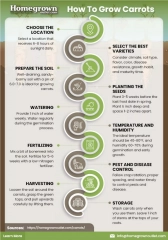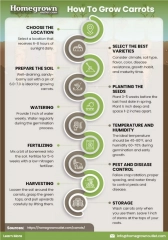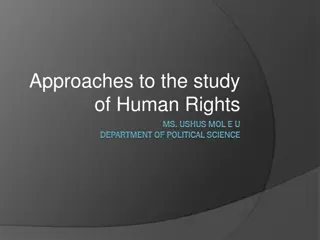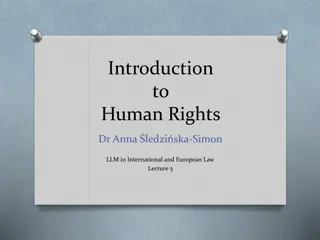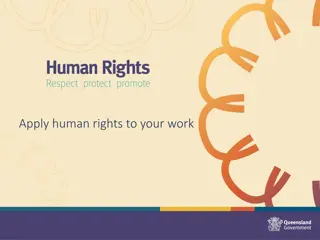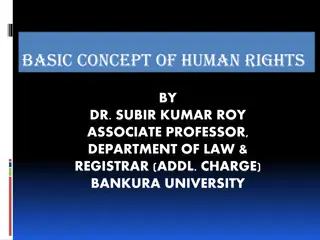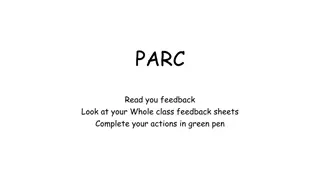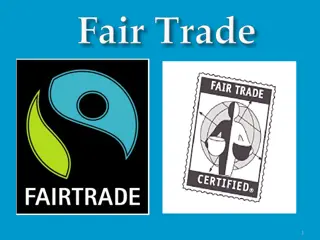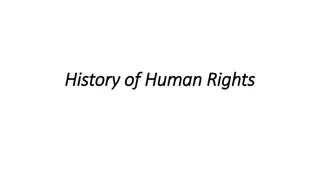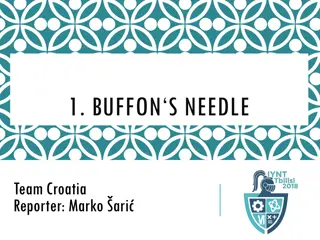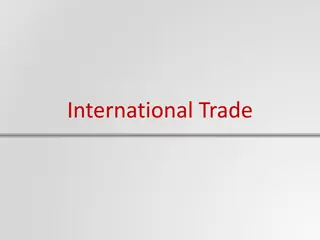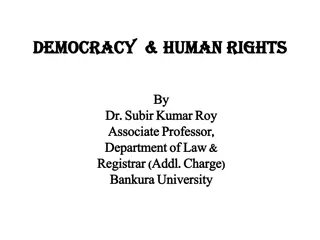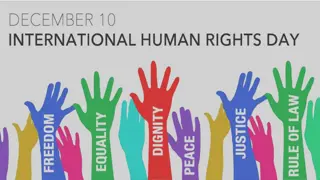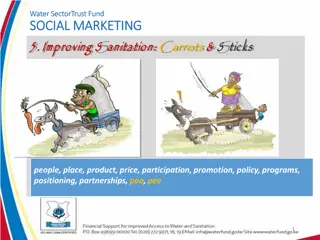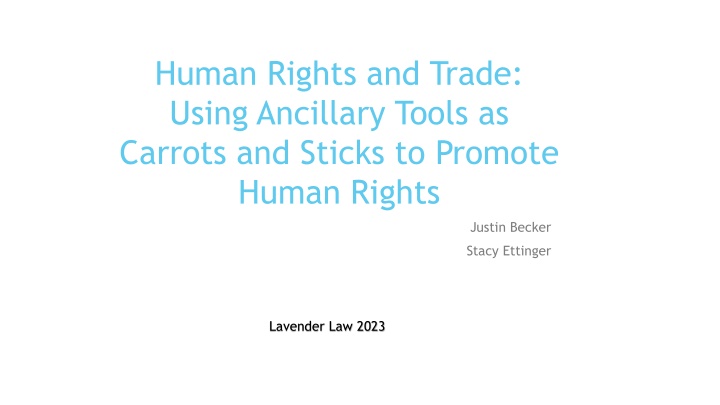
Carrots and Sticks: Promoting Human Rights Through Trade
Intersection between human rights and trade is explored, focusing on using ancillary tools as carrots and sticks to advance human rights in the context of trade agreements. Various mechanisms such as FTAs, WROs, UFLPA, and sanctions are discussed for promoting and enforcing human rights in trade relations.
Download Presentation

Please find below an Image/Link to download the presentation.
The content on the website is provided AS IS for your information and personal use only. It may not be sold, licensed, or shared on other websites without obtaining consent from the author. If you encounter any issues during the download, it is possible that the publisher has removed the file from their server.
You are allowed to download the files provided on this website for personal or commercial use, subject to the condition that they are used lawfully. All files are the property of their respective owners.
The content on the website is provided AS IS for your information and personal use only. It may not be sold, licensed, or shared on other websites without obtaining consent from the author.
E N D
Presentation Transcript
Human Rights and Trade: Using Ancillary Tools as Carrots and Sticks to Promote Human Rights Justin Becker Stacy Ettinger Lavender Law 2023
Carrots and Sticks: Promoting Human Rights Through Trade-Related Tools Overview of Presentation Overview and Context of the Intersection Between Human Rights and Trade Carrot - FTAs Recent Human Rights Provisions in FTAs Enforcement of FTAs Stick Withhold Release Orders (WROs), Uighur Forced Labor Prevention Act (UFLPA), and Sanctions Overview of WROs, UFLPA, and Sanctions Promoting Human Rights Enforcement of WROs, UFLPA, and Sanctions Promoting Human Rights through FTAs, WROs, UFLPA and Sanctions vs. Other International Agreements and Conventions Future Use of FTAs, WROs, UFLPA, and Sanctions and Whether They are Effective and Should be Used 2
Intersection Between Human Rights and Trade Context and Overview Trade and Human Rights is nothing new. Ancient Times to Rise of European Nation States and Colonialism To Trade, is also to raid, and to protect. Western (European) civilization and Trade distinguishing features: Nation State; New World (scale); the limited liability corporation. Colonialism: Examples: Honorable Gentlemen of East India Company and geographical morality; civilizing mission of trade; Congo Free Association and Native Right ILO creation: state failure to protect labor rights could distort trade and undermine labor rights in other countries. Framing of Intersection Post WWII The Post WWII economic order: creation of economic/non-economic distinction. Silos: international Human Rights law vs. international economic law Cold War and visions of human rights: Civil and Political Rights, Economic, Social and Cultural Rights. End of Cold War and demise of economic/non-economic distinction: rise of regulatory state 3
Intersection Between Human Rights and Trade (cont d) 1980s-1990s aspirational and nonbinding human rights language in some preferential trade agreement NAFTA 1993 labor and environment side agreements. (Rise of international environmental movement). Sustainable Development and Trade: WTO Preamble Transparency and China Problem New generation of Trade Agreements: US-Mexico-Canada Agreement (USMCA or NAFTA 2.0), Comprehensive and Progressive Agreement for Trans-Pacific Partnership (CPTTP), etc. Demise of the Dispute Settlement mechanism 4
Carrot: Introduction to FTAs Primary Purpose: to facilitate trade and eliminate trade barriers between two or more countries Reduce tariffs, quotas, or other impediments to imports and exports between the Parties Provide for a more stable and transparent trading and investment environment with enhanced rule of law (e.g., dispute resolution mechanisms, intellectual property right protections) Offer opportunities to sell to the government through procurement contracts Provide protections and rights to private parties such as investors Examples of FTAs United States-Mexico-Canada Agreement (USMCA) successor to the North American Free Trade Agreement (NAFTA) Comprehensive and Progressive Agreement for a Trans-Pacific Partnership (CPTTP) World Trade Organization (WTO) & the General Agreement on Tariffs and Trade (GATT) The United States has FTAs with 20 countries 5
Recent Human Rights Provisions in FTAs Labor: Chapter 23 of the USMCA Provisions to prevent violence against workers, forced labor, and child labor and protections/recognition of freedom of association and right to collective bargaining Annex 23-A on Collective Bargaining is specific to Mexico Women s Rights: Article 23.4 of CPTPP (Women and Economic Growth) Enhancing the ability of women to access and benefit from the opportunities created by the agreement. 6
Recent Human Rights Provisions in FTAs (contd) LGBTQ+: Article 23.9 of the USMCA (Discrimination in the Workplace) Each Party shall implement policies15that it considers appropriate to protect workers against employment discrimination on the basis of sex (including with regard to sexual harassment), pregnancy, sexual orientation, gender identity, and caregiving responsibilities; provide job- protected leave for birth or adoption of a child and care of family members; and protect against wage discrimination. (emphasis added). Footnote 15 Carve-out stating that current U.S. federal policies fulfill the obligations of this article and this provision does not require any amendment to Title VII of the Civil Rights Act of 1964. (Negotiated prior to the Supreme Court s decision in 2020 finding that Title VII of the Civil Rights Act of 1964 prohibits employment discrimination on the basis of an individual s sexual orientation or transgender status.) EU Essential Elements Approach: Human rights are essential elements of the agreement which means that a Party can partially or fully suspend an agreement unilaterally if the element is breached. Article 1 of EU-Colombia-Peru Agreement: Respect for democratic principles and fundamental human rights, as laid down in the Universal Declaration of Human Rights, and for the principle of the rule of law, underpins the internal and international policies of the Parties. Respect for these principles constitutes an essential elementof this Agreement. 7
FTA Enforcement Monitoring and Sanctions Parties establish monitoring to identify noncompliance within their borders and impose sanctions for violations example: monitoring labor laws in Article 23.5 of USMCA. State-State Dispute Resolution example: WTO Panels and Appellate Body Consultations Panel Implementation Appellate Body Adjudicating Bodies Investor-States Dispute Resolution (ISDS) An investor can challenge a state for violations of the FTA, usually before arbitral tribunals 8 Soft Power: Political Leverage
Sticks: UFLPA, WROs, and Sanctions Withhold Release Orders ( WROs ) Section 307 of the Tariff Act of 1930 (19 USC 1307) prohibits the importation of merchandise mined, produced or manufactured, wholly or in part, in any foreign country by convict labor and/or forced or indentured labor, including child labor. Recent US FTAs commit countries to maintain laws on core ILO rights/principles. US Customs and Border Protection (CBP) uses the UN ILO indicators of forced labor to inform its identification of forced labor practices. CBP can issue a WRO (pursuant to 19 CFR 12.42(e)) if it believes imports are the product of forced labor. Companies may contest the WRO. Prohibitions can be country, region, or entity specific. The majority of WROs are against China. Recent examples: cotton and tomatoes from Xinjiang Uyghur Autonomous Region of China; seafood from certain Chinese fishing vessels; disposable gloves from Malaysia; diamonds from Marange diamond fields in Zimbabwe. 9
Sticks: UFLPA, WROs and Sanctions Uighur Forced Labor Prevention Act ( UFLPA ) Historical Basis 2017 Present: reports of ethnic minority groups detained in internment camps for indefinite periods in the Xinjiang Uyghur Autonomous Region (XUAR) of the People s Republic of China 11 WROs issued between 2019 and 2021 targeting products and companies believed to be connected to forced labor in XUAR 2017 2020: paradigm shift in US-China trade policies under the Trump administration December 2021: Congress passes the Uyghur Forced Labor Prevention Act; President Biden signs it into law on December 23, 2021 The UFLPA requires CBP to apply a presumption that any goods, wares, articles, and merchandise mined, produced, or manufactured wholly or in part in the Xinjiang Uyghur Autonomous Region of China, or by certain listed entities, are made with forced labor and, therefore, are prohibited from importation into the United States. UFLPA, 3(a). 10
Sticks: UFLPA, WROs and Sanctions (contd) Sanctions Sanctions are restrictive measures imposed by international organizations (eg, United Nations) or separate countries (eg, US, EU, UK) to achieve specific foreign policy or national security objectives. U.S. sanctions program can be 1) comprehensive country-based; 2) list based (ie, targeting specific individuals or entities); 3) sectoral based (ie, targeting individuals or entities in defined industries); or 4) secondary (ie, targeting non-U.S. persons involved in transactions with certain countries. The U.S. maintains sanctions on multiple foreign governments it has identified as egregious violators of international human rights norms, democratic governance, or corruption standards, including Belarus, Cuba, Democratic Republic of the Congo, Nicaragua, North Korea, Russia, Somalia, Venezuela, and Yemen. Sanctions have been vigorously used against Russia by the United States and many other nations in response to the Russia-Ukraine War. 11
Sticks: Enforcement of UFLPA, WROs, and Sanctions Trade agreements have expanded coverage of trade and labor issues in part because the World Trade Organization (WTO) does not cover such rules, deferring to the International Labor Organization (ILO). Convict/Child Labor. In the U.S., imported merchandise subject to WRO because it is produced by convict or child labor is subject to exclusion and/or seizure, and may lead to criminal investigation of the importer. International Human Rights. Intended economic impact of various U.S. sanctions by design varies widely. Some sanctions are designed to have a broad, destabilizing effect on a target country s economy, often in an effort to seek significant changes in the government s behavior or a change in government. E.g., targeting a key revenue-producing sector like oil (e.g., Venezuela), or restrictions Russian companies access to U.S. financing to disrupt availability of credit for Russian state-owned or politically connected firms. Other sanctions are designed to put targeted economic pressure on key decisionmakers while minimizing collateral damage for the target country s citizens and U.S. economic interests eg, freezing U.S. assets of individual foreign person. 12
Promoting Human Rights through FTAs and Sanctions vs. Other International Agreements and Conventions United Nations International Conventions and Covenants Other International Agreements and Conventions Promoting Human Rights International Covenant on Civil and Political Rights Convention on the Elimination of All Forms of Discrimination against Women UN Human Rights Council Resolutions Protection against violence and discrimination based on sexual orientation and gender identity (A/HRC/RES/32/2) UN International Labor Organization (ILO) FTAs and Sanctions vs. Other International Agreements and Covenants Effectiveness and Enforcement Do they serve the same purpose? Are they complementary? 13
Future of FTAs and Sanctions as a Tool to Promote Human Rights FTAs and Sanctions Themselves May Raise Concerns Related to Human Rights UN Human Rights Counsel in 2019 found that US sanctions against Cuba, Venezuela, and Iran violated human rights, including potential starvation of people Loss of employment due to increased foreign competition Loss of tariff revenue, which could be used to fund social services Encroachment on indigenous and cultural rights Decreased access to food and medicines because of increased IP protections see current discussion related to TRIPS Agreement waiver for COVID-19 vaccines Developed vs. Developing World Inequality in negotiating powers Exclusion of the poorest nations Fails to Capture Worst Human Rights Offenders 14

